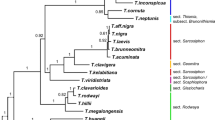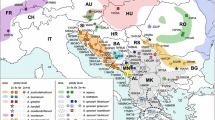Abstract
We carried out genetic and morphometric analyses in 33 populations belonging to all nine described and one putative taxa of Chamaecrista subsect. Baseophyllum. Genetic variability was low in all taxa. Morphological and genetic data are consistent with the status of C. depauperata and C. coriacea. However, divergence between C. cytisoides var. cytisoides and all the other six conspecific varieties is higher than the divergence between it and the other two species. Our data support the recognition of eight species in the subsection Baseophyllum. Chamaecrista coriacea and C. depauperata are supported in their original circumscription. However, the varieties ascribed to C. cytisoides are best treated as six different species. We propose five new combinations in order to raise varieties of C. cytisoides to specific rank: C. blanchetii, C. brachystachya, C. confertiformis, C. decora, C. unijuga. We also propose synonimization of one variety, C. cytisoides var. micrantha, under C. brachystachya.
Similar content being viewed by others
References
Avise JC (1994). Molecular markers, natural history and evolution. Chapman & Hall, New York
Baatout H, Marrakchi M and Combes D (1991). Genetic divergence and allozyme within and among populations of Hedysarum spinosissimum subsp. capitatum and subsp. spinosissimum (Papilionaceae). Taxon 40: 239–252
Bentham G (1840). Leguminosae. J Bot (Hooker ) 2: 78
Bentham G (1870) Cassia. In: Martius (ed) F. Brasiliensis 15: 82–176
Bentham G (1871). Revision of the genus Cassia. Trans Linn Soc London 27: 503–591
Boonkerd T, Pechsri S and Baum BR (2005). A phenetic study of Cassia sensu lato (Leguminosae-Caesalpinioideae: Cassieae: Cassiinae) in Thailand. Pl. Syst Evol 232: 153–165
Borba EL, Felix JM, Semir J and Solferini VN (2000). Pleurothallis fabiobarrosii, a new Brazilian species: morphological and genetic data with notes on the taxonomy of Brazilian rupicolous Pleurothallis. Lindleyana 15: 2–9
Borba EL, Felix JM, Solferini VN and Semir J (2001). Fly-pollinated Pleurothallis (Orchidaceae) species have high genetic variability: evidence from isozyme markers. Amer J Bot 88: 419–428
Borba EL, Shepherd GJ, van den Berg C and Semir J (2002). Floral and vegetative morphometrics of five Pleurothalis (Orchidaceae) species: correlation with taxonomy, phylogeny, genetic variability and pollination systems. Ann Bot 90: 219–230
Brune W, Alfenas AC and Junghans TG (1998). Identificações específicas de enzimas em géis. In: Alfenas, AC (eds) Eletroforese de isoenzimas e proteinas afins: fundamentos e aplicações em plantas e microorganismos, pp 201–328. Universidade Federal de Viçosa, Viçosa
Casiva PV, Saidman BO, Vilardi JC and Cialdella AM (2002). First comparative phenetic studies of Argentinean species of Acacia (Fabaceae), using morphometric, isozymal, and RAPD approaches. Amer J Bot 89: 843–853
Chamberlain J (1998). Isozyme variation in Calliandra calothyrsus (Leguminosae): its implications for species delimitation and conservation. Amer J Bot 85: 37–47
Clayton JW and Tretiak DN (1972). Amine-citrate buffers for pH control in starch gel eletrophoresis. J Biol Board Canada 29: 1169–1172
Conceição AS (2000) O gênero Chamaecrista Moench (Leguminosae-Caesalpinioideae) em Catolés, Abaíra, Chapada Diamantina-BA-Brasil. M.Sc. Thesis, Universidade Federal de Pernambuco, Recife
Conceição AS (2006) Filogenia do gênero Chamaecrista (Leguminosae-Caesalpinioideae) e taxonomia do grupo Baseophyllum. Ph.D. Thesis, Universidade Estadual de Feira de Santana, Feira de Santana
Conceição AS, Queiroz LP and Lewis GP (2001). Novas espécies de Chamaecrista Moench (Leguminosae-Caesalpinioideae) da Chapada Diamantina, Bahia, Brasil. Sitientibus série Ciências Biológicas 1: 112–119
Corrias B, Rossi W, Arduino P, Cianchi R and Bullini L (1991). Orchis longicornu Poiret in Sardinina: genetic, morphological and chorological data. Webbia 45: 71–101
Costa CBN (2007) Mecanismos de isolamento reprodutivo em espécies simpátricas: biologia reprodutiva de Chamaecrista (Leguminosae-Caesalpinioideae) em Mucugê, Bahia. Ph.D. Thesis, Universidade Estadual de Feira de Santana, Feira de Santana
Crawford DJ (1989). Enzyme electrophoresis and plant systematics. In: Soltis, DE and Soltis, PS (eds) Isozymes in plant biology, pp 146–164. Dioscorides Press, Portland
Elisens WJ, Boyd RD and Wolfe AD (1992). Genetic and morphological divergence among varieties of Aphanostephus skirrhobasis (Asteraceae-Astereae) and related species with different chromosome numbers. Syst Bot 17: 380–394
Gilles BE (1984). A comparison between quantitative and biochemical variation in the wild barley Hordeum murinum. Evolution 38: 34–41
Goldman DH, van den Berg C and Griffith MP (2004). Morphometric circumscription of species and infraspecific taxa in Calopogon R. Br. (Orchidaceae). Pl Syst Evol 274: 37–60
Hamrick J L and Godt M J (1992). Allozyme diversity in plant species. In: Brown, AHD, Clegg, MT, Kahler, AL and Weir, BS (eds) Plant population genetics, breeding and genetic resources, pp 43–63. Sinauer, Sunderland
Henderson A (2006). Traditional morphometrics in plant systematics and its role in palm systematics. Bot J Linn Soc 151: 103–111
Irwin HS and Barneby RC (1978). Monographic studies in Cassia (Leguminosae). III. Sections Absus and Grimaldia. Mem New York Bot Gard 30: 1–300
Irwin HS and Barneby RC (1982). The American Cassinae: a synoptical revision of Leguminosae tribe Cassieae subtribe Cassinae in the New World. Mem New York Bot Gard 35: 1–918
Lambert SM, Borba EL, Machado MC and Andrade SCS (2006a). Allozyme diversity and morphometrics of Melocactus paucispinus (Cactaceae) and evidence for hybridization with M. concinnus in the Chapada Diamantina, North-eastern Brazil. Ann Bot 97: 389–403
Lambert SM, Borba EL and Machado MC (2006b). Allozyme diversity and morphometrics of the endangered Melocactus glaucescens (Cactaceae), and investigation of the putative hybrid origin of Melocactus × albicephalus (Melocactus ernestii × M. glaucescens) in north-eastern Brazil. Pl Spec Biol 21: 93–108
Leht M and Jaaska V (2002). Cladistic and phenetic analysis of relationships in Vicia subgenus Vicia (Fabaceae) by morphology and isozymes. Pl Syst Evol 232: 237–260
Levene H (1949). On a matching problem arising in genetics. Ann Math Statist 20: 91–94
Levin DA (2000). The origin, expansion and demise of plant species. Oxford University Press, New York
Lewis GP (2005). Tribe Cassieae. In: Lewis, GP, Schrire, B, MacKinder, B and Lock, M (eds) Legumes of the world, pp 111–124. Royal Botanical Gardens, Kew
Liston A (1992). Isozyme systematics of Astragalus sect. Leptocarpi subsect. Californici (Fabaceae). Syst Bot 17: 367–379
McCune B, Mefford MJ (1999) PCOrd-Multivariate analysis of ecological data, version 4.10. MjM Software, Gleneder Beach
Mitton JB (1978). Relationship between heterozygosity for enzyme loci and variation of morphological characters in natural populations. Nature 273: 661–662
Nei M (1978). Estimation of average heterozygosity and genetic distance from a small number of individuals. Genetics 89: 583–590
Pereira ACS, Borba EL and Giulietti AM (2007). Genetic and morphological variability of the endangered Syngonanthus mucugensis Giul. (Eriocaulaceae), from the Chapada Diamantina, Brazil implications for conservation and taxonomy. Bot J Linn Soc 153: 401–416
Ridgway GJ, Sherburne SW and Lewis RD (1970). Polymorphism in the esterases of Atlantic herring. Transactions of the American Fisheries Society 99: 147–151
Riggins R, Pimentel RA and Walters DR (1977). Morphometrics of Lupinus nanus (Leguminosae) I. Variation in natural populations. Syst Bot 2: 317–325
Shaw CR and Prasad R (1970). Starch gel eletrophoresis of enzymes-a compilation of recipes. Biochem Genet 4: 297–320
Silva-Pereira V (2007) Fluxo gênico e estrutura genética espacial em micro-escala em população de Chamaecrista blanchetii (Leguminosae) em campo rupestre na Chapada Diamantina, nordeste do Brasil. Ph.D. Thesis, Universidade Estadual de Feira de Santana, Feira de Santana
Sneath PHA and Sokal RR (1973). Numerical taxonomy. Freeman and Co, San Francisco
Soltis DE, Haufler CH, Darrow DC and Gastony GJ (1983). Starch gel electrophoresis of ferns: a compilation of grinding buffers, gel and electrode buffers, and staining schedule. Amer Fern J 73: 9–27
Sotuyo S, Contreras JL, Delgado-Salinas A and Oyama K (2004). Genetic diversity and structure of the endemic Caesalpinia hintonii complex (Leguminosae: Caesalpinioideae) in Mexico. Pl Syst Evol 247: 131–143
StatSoft INS (2000). Statistica for windows (computer program manual). Salf Soft Inc, Tulsa
Swofford DL and Selander RB (1989). BIOSYS-1: computer program for the analysis of allelic variation in population genetics and biochemical systematics. Illinois Natural History Survey, Champaign
Thorpe JP (1982). The molecular clock hypothesis: biochemical evolution, genetic differentiation and systematics. Annual Rev Ecol Syst 13: 139–168
van der Bank H, van der Bank M, van Wyk B (2001). A review of the use of allozyme eletrophoresis in plant systematics. Biochem Syst & Ecol 29: 469–483
Wright S (1978). Evolution and the genetics of populations: variability within and among natural populations vol 4. University of Chicago Press, Chicago
Author information
Authors and Affiliations
Corresponding author
Rights and permissions
About this article
Cite this article
Conceição, A.S., Queiroz, L.P., Lambert, S.M. et al. Biosystematics of Chamaecrista sect. Absus subsect. Baseophyllum (Leguminosae-Caesalpinioideae) based on allozyme and morphometric analyses. Plant Syst Evol 270, 183–207 (2008). https://doi.org/10.1007/s00606-007-0604-4
Received:
Accepted:
Published:
Issue Date:
DOI: https://doi.org/10.1007/s00606-007-0604-4




